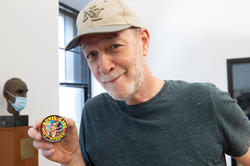Submissions to the eighth annual Baker & Whitehill Student Artists’ Book Contest beautifully marry craft and content.
Stacked and Altered

What is a book’s purpose after it has been read and put down for the last time? New York-based artist Jared Bark has spent recent years exploring questions like this by physically manipulating used books to give them new meaning—removing their covers and bindings, cutting them into new shapes and even charring them with a blow torch.
Recently, at the suggestion of former Metropolitan Museum of Art curator Maria Morris Hambourg, Dean of Libraries Margot Nishimura reached out to Bark about showcasing his work in Stacked & Altered, an exhibition on view in RISD’s Fleet Library until early October.

Upon entering the library, one is confronted by books that have been put through a sawmill, glued together, left outside to slowly disintegrate or even had holes bored into them. “The way that the work communicates with the rest of the library is so great,” says Nishimura. “Jared’s early work using photo booths across New York City is really interesting to think about in relation to this. He has an instinct for taking things apart and recombining them in compelling ways.”
“The way that the work communicates with the rest of the library is so great. [Jared] has an instinct for taking things apart and recombining them in compelling ways.”
As a young artist, Bark kicked off his career with performance, body art and minimalist abstraction, often working with common household objects such as eye droppers, cling wrap and kitchen matches. More than a decade later, he put his art on pause to focus on his picture-framing company Bark Frameworks before returning to the studio full-time in 2012 to begin his work transforming books.

Having grown up in a scholarly family, Bark says he was surrounded by books from a young age. “I spent a lot of time in the stacks as a teenager, so the idea of using them in a different way appeals to me,” says the artist.
“I spent a lot of time in the stacks as a teenager, so the idea of using them in a different way appeals to me.”
In Library Table (2019), which is installed by the library entrance, a cut up and rejoined library table holds four columns of books that have been similarly cut and resized. “You could call this a ‘reduced library table,’” Bark says. “The books have been cut down to squares of the same size. You almost can’t recognize them.”

Bark originally envisioned these stacks as replacements for felled trees. “I thought about how these books are made of wood pulp,” he says, “and wanted to return them to their place of origin.” Over the years, Bark’s work with books has evolved from the nature-oriented installations in his Book Stacks in the Field collection to more heavily manipulated pieces such as Burned Book Stack (2018), a 61-inch column of books charred from the top down.

In deciding which pieces were best for the exhibition, Nishimura, graduate assistant Priyata Bosamia MDes 23 and Head of Campus Exhibitions Mark Moscone 88 PR flipped through Bark’s recent publication Book of Stacks, Stack of Books and visited his studio to familiarize themselves with his work. Bosamia and Special Collections Librarian Claudia Covert also selected a number of artists’ books from the library’s Artists' Book Collection that complement Bark’s work in surprising ways. “The altered books we selected showcase various methods, approaches and processes involved in altering books,” Bosamia says.
One of the altered books on display is Erin K. Schmidt’s The End of the Wasp Season, its pages fastened into the shape of brood cells with whirlwind-bound books tucked into the cells like larvae. In another piece, Bok 3b und Bok 3d, Dieter Roth die-cut, trimmed and bound together pages from various children’s comics and coloring books.

Bosamia also designed the graphics for the show. “I really enjoyed creating the exhibition's graphic identity and design,” she says. “In selecting typography and colors, I ensured that they reflected the nature and themes of the artworks.” The grad student is also interning with MASS Design Group this summer, a community-driven organization that aims to expand access to design in Boston. “The internship contributes to my work at RISD,” she says, “including my thesis project, which will focus on trauma-informed design in cultural spaces.”
“These books have been out of circulation for decades, and this gives them a new life. It makes us rethink our relationship with books.”
“The discomfort of seeing the books cut up makes the work particularly effective in this space,” Nishimura says of Stacked & Altered. “These books have been out of circulation for decades, and this gives them a new life. It makes us rethink our relationship with books.”
—Isabel Roberts
August 9, 2022


